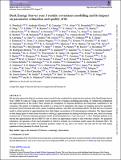Por favor, use este identificador para citar o enlazar a este item:
http://hdl.handle.net/10261/254807COMPARTIR / EXPORTAR:
 SHARE SHARE
 CORE
BASE CORE
BASE
|
|
| Visualizar otros formatos: MARC | Dublin Core | RDF | ORE | MODS | METS | DIDL | DATACITE | |

| Título: | Dark Energy Survey year 3 results: covariance modelling and its impact on parameter estimation and quality of fit |
Autor: | Friedrich, O.; Porredon, A. CSIC ORCID CVN; Crocce, Martín CSIC ORCID; Fosalba, Pablo CSIC ORCID; Ávila, Santiago; García-Bellido, Juan CSIC ORCID; Gaztañaga, Enrique CSIC ORCID; Serrano, Santiago CSIC ORCID; Wilkinson, Reese D.; DES Collaboration | Palabras clave: | Large-scale structure of the universe Cosmology: observations |
Fecha de publicación: | 27-ago-2021 | Editor: | Oxford University Press Royal Astronomical Society |
Citación: | Monthly Notices of the Royal Astronomical Society 508(3): 3125-3165 (2021) | Resumen: | We describe and test the fiducial covariance matrix model for the combined two-point function analysis of the Dark Energy Survey Year 3 (DES-Y3) data set. Using a variety of new ansatzes for covariance modelling and testing, we validate the assumptions and approximations of this model. These include the assumption of Gaussian likelihood, the trispectrum contribution to the covariance, the impact of evaluating the model at a wrong set of parameters, the impact of masking and survey geometry, deviations from Poissonian shot noise, galaxy weighting schemes, and other sub-dominant effects. We find that our covariance model is robust and that its approximations have little impact on goodness of fit and parameter estimation. The largest impact on best-fitting figure-of-merit arises from the so-called fsky approximation for dealing with finite survey area, which on average increases the χ2 between maximum posterior model and measurement by 3.7 per cent (Δχ2 ≈ 18.9). Standard methods to go beyond this approximation fail for DES-Y3, but we derive an approximate scheme to deal with these features. For parameter estimation, our ignorance of the exact parameters at which to evaluate our covariance model causes the dominant effect. We find that it increases the scatter of maximum posterior values for Ωm and σ8 by about 3 per cent and for the dark energy equation-of-state parameter by about 5 per cent. | Descripción: | Friedrich, O., et al. DES Collaboration | Versión del editor: | https://doi.org/10.1093/mnras/stab2384 | URI: | http://hdl.handle.net/10261/254807 | DOI: | 10.1093/mnras/stab2384 | E-ISSN: | 1365-2966 |
| Aparece en las colecciones: | (ICE) Artículos |
Ficheros en este ítem:
| Fichero | Descripción | Tamaño | Formato | |
|---|---|---|---|---|
| DES_year_3_results.pdf | 3,61 MB | Adobe PDF |  Visualizar/Abrir |
CORE Recommender
SCOPUSTM
Citations
44
checked on 21-abr-2024
WEB OF SCIENCETM
Citations
29
checked on 27-feb-2024
Page view(s)
46
checked on 23-abr-2024
Download(s)
58
checked on 23-abr-2024
Google ScholarTM
Check
Altmetric
Altmetric
Este item está licenciado bajo una Licencia Creative Commons

